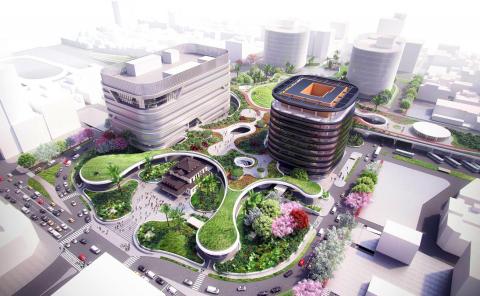Design plans for a remodeling of the historic Kaohsiung Railway Station submitted by the Dutch design studio Mecanoo have been approved by the Kaohsiung Urban Development Bureau, the bureau announced on Thursday.
The Ministry of Transportation and Communications’ plans for renovating Kaohsiung Railway Station began in 2000, but locals criticized initial plans, saying they lacked functionality, both from business and transportation points of view, and did not fit into the surroundings.
In response, the city held a series of meetings on the issues and established a communication platform to exchange ideas. The ministry then entrusted the station’s design to Mecanoo, which created a “stunning” design that both the local and central governments were pleased with, city officials said.

Photo: courtesy of Mecanoo
“The station design provides a large outdoor activity area for local residents and, taking into account the stifling heat of the south, provides lots of greenery for shade, emulating the experience of being in a traditional Taiwanese temple courtyard. The unconventional oval-shaped lights in the canopy’s ceiling create impressions of a temple lantern festival,” Kaohsiung Urban Development Bureau Director-General Lee Yi-de (李怡德) said.
Parallel walking trails and cycling paths stretch for 15km through the top of the canopy connecting the eastern and western peripheries. Climbing the station’s canopies, visitors can take in the beauty of the Shoushan (壽山) and Beidawu (北大武山) mountains in the distance.
“To create a sense of melding the old and the new, the old colonial-era Japanese station is to be moved to a spot along the central axis of the new station. The encircling of the old station by the new one will lend itself to an atmosphere of continued traditions,” Lee said.
The publishing of a simulated image of the new station a few days ago by the Architect’s Newspaper proved popular online. Netizens called the design “stunning” and asked: “Can Taipei Railway Station still be saved?”
“The station’s design escapes the old engineering thought process of prioritizing functionality and takes the liberation of space brought about by underground transportation a step further, acting as an important marker for emphasis on activity space for the public,” a bureau statement said.
After deliberating on the new plans, the ministry would be urged to begin work on the project as soon as possible, with the aim of completing the station by 2023, bureau officials said.

A strong continental cold air mass is to bring pollutants to Taiwan from tomorrow, the Ministry of Environment said today, as it issued an “orange” air quality alert for most of the country. All of Taiwan except for Hualien and Taitung counties is to be under an “orange” air quality alert tomorrow, indicating air quality that is unhealthy for sensitive groups. In China, areas from Shandong to Shanghai have been enveloped in haze since Saturday, the ministry said in a news release. Yesterday, hourly concentrations of PM2.5 in these areas ranged from 65 to 160 micrograms per cubic meter (mg/m³), and pollutants were

Taiwan’s armed forces have established response protocols for a wide range of sudden contingencies, including the “Wan Chun Plan” to protect the head of state, the Ministry of Defense (MND) said today. After US President Donald Trump on Saturday launched a series of airstrikes in Venezuela and kidnapped Venezuelan President Nicolas Maduro, concerns have been raised as to whether China would launch a similar “decapitation strike” on Taiwan. The armed forces regularly coordinate with relevant agencies and practice drills to ensure preparedness for a wide range of scenarios, Vice Minister of National Defense Hsu Szu-chien (徐斯儉) told reporters before a

EVA Airways on Saturday said that it had suspended a pilot and opened an investigation after he allegedly lost his temper and punched the first officer several times as their plane was taxiing before takeoff at Los Angeles International Airport. According to a report published on Thursday by The Reporter, the incident occurred after the flight’s Malaysian first officer tried to warn the Taiwanese pilot, surnamed Wen (文), that he was taxiing faster than the speed limit of 30 knots (55.6kph). After alerting the pilot several times without response, the first officer manually applied the brakes in accordance with standard operating

NOT AN OPENING: Trump’s violation of international law does not affect China’s consideration in attacking Taiwan; Beijing lacks capability, not precedent, an official said Taiwanese officials see the US’ capture of the president of Venezuela as a powerful deterrent to Beijing’s aggression and a timely reminder of the US’ ability to defeat militaries equipped with Chinese-made weapons. The strikes that toppled Venezuelan President Nicolas Maduro signaled to authoritarian leaders, including Chinese President Xi Jinping (習近平), US President Donald Trump’s willingness to use military might for international affairs core to US interests, one senior official in Taipei’s security circle said. That reassured Taiwan, the person said. Taipei has also dismissed the idea that Trump’s apparent violation of international law could embolden Beijing, said the official, who was not